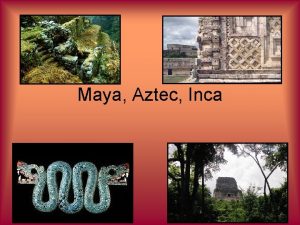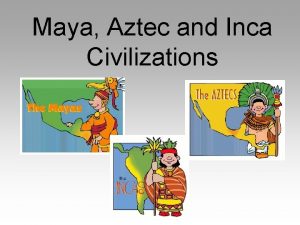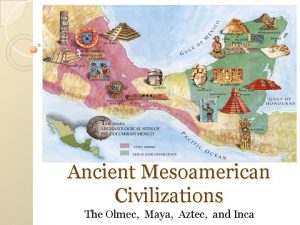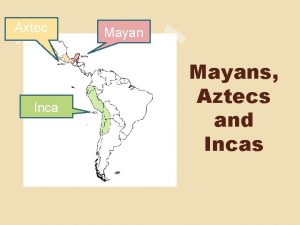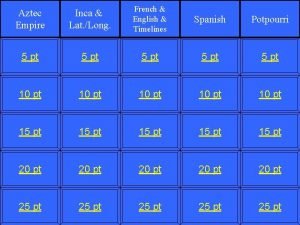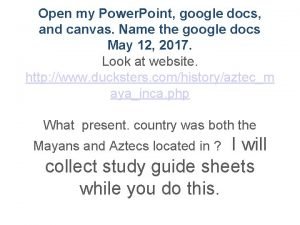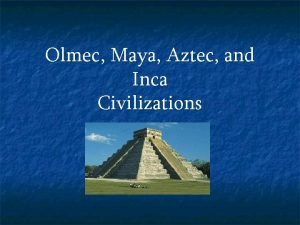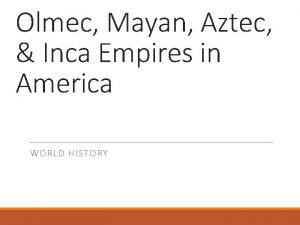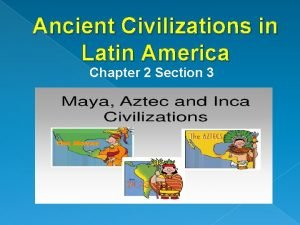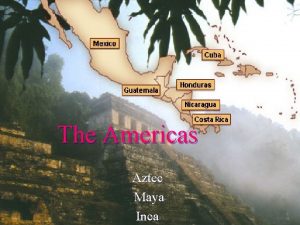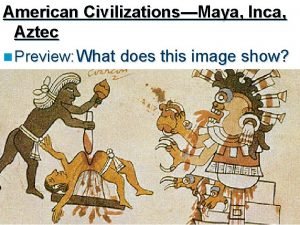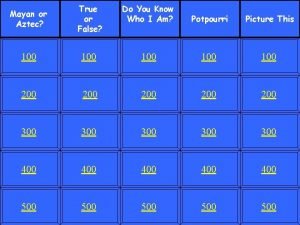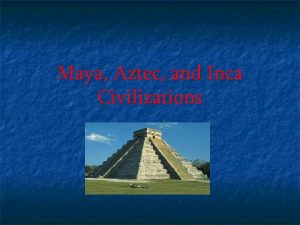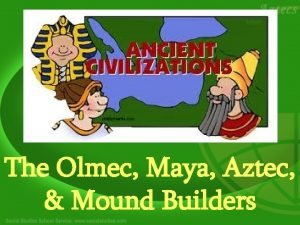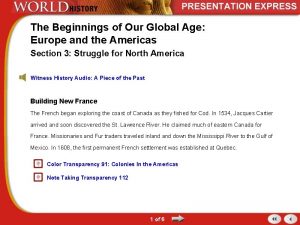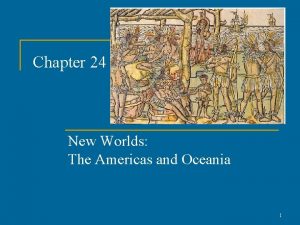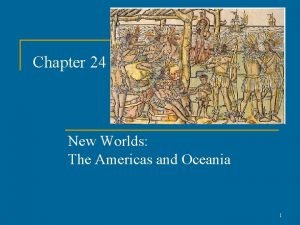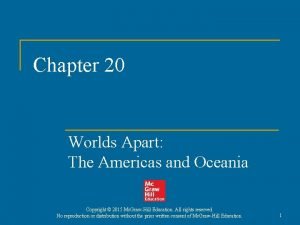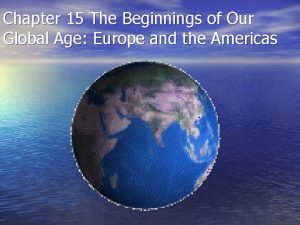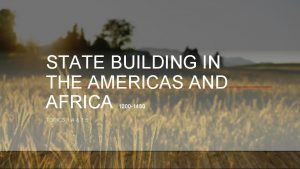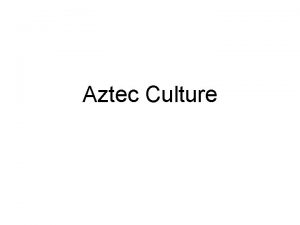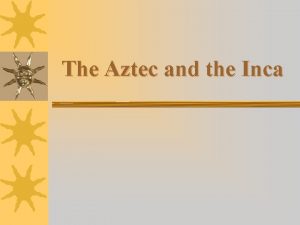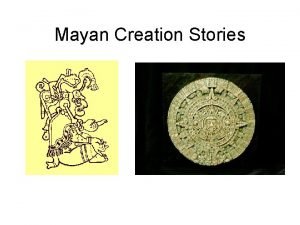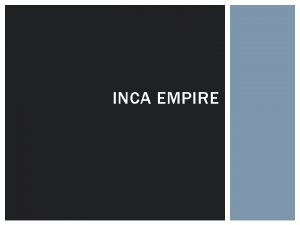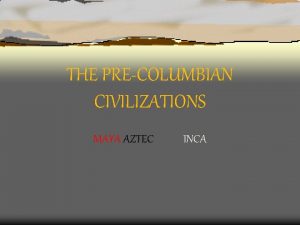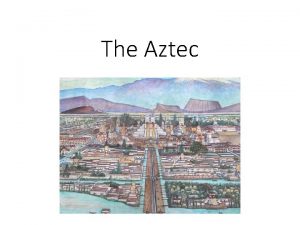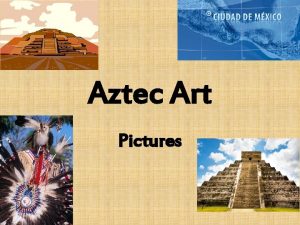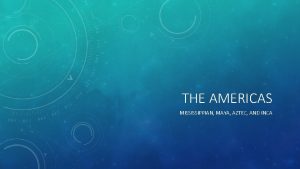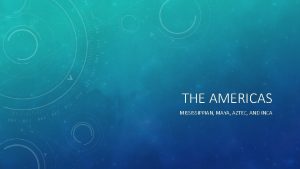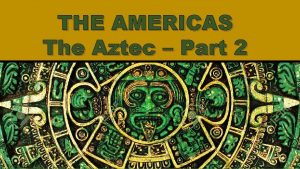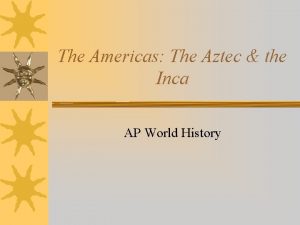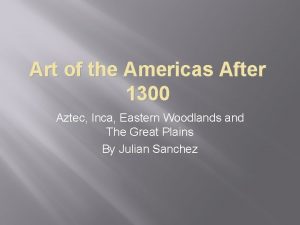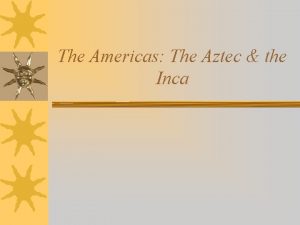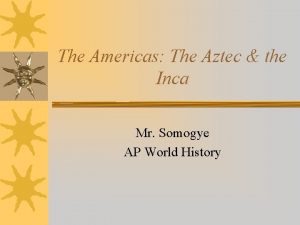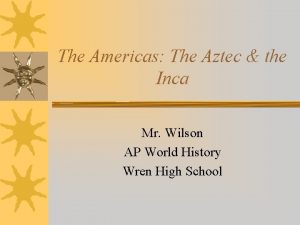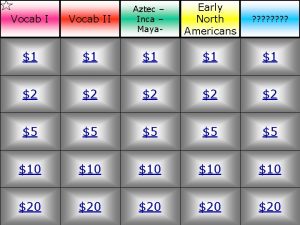Early Americas Mayan Aztec and Inca Section One




































- Slides: 36

Early Americas Mayan, Aztec and Inca

Section One MAYAN EMPIRE

The Olmec Civilization • First urban civilization in Mesoamerica • Developed first writing system in the Americas • Traded with others from far away • Civilization ended around 400 BC

The Mayan Empire • Developed around 1000 BC • Grew to more than 40 cities of up to 50, 000 people each • Spread throughout the Yucatan Peninsula • Traded goods to different areas of Mesoamerica

Mayan Cities • Built large pyramids, temples, and palaces • Canals built to control the flow of water through cities • Large plazas used for public events • Hillsides turned into flat terraces so crops could be grown close to cities • Battled against each other to gain power

Mayan Society • Divided into lower and upper class • Upper class included kings, priests, warriors, and merchants • Lower class included all others • Slaves held the lowest position in society

Mayan Religion • Worshipped many gods • Most important god was Itzamna • People believed they had to please the gods by offering human blood • Believed that Gods had attempted to create humans 3 times: 1 st Mud, 2 nd Wood, 3 rd Maize

Mayan Achievements • Art and architectural achievements (Mayan Cities) • Built cities using metal tools • Built observatories to study the stars • Developed the calendar and number systems • Also developed a writing system similar to Egyptian hieroglyphics

Mayan Math

End of the Mayan Empire • Began to collapse around 900 AD • Cause of the collapse is unknown The three main theories of why the Mayan Empire declined are… 1. Warfare may have contributed 2. Kings made demands of people and they may have rebelled 3. A long period of dry weather may have made it hard to grow crops • A mix of events probably led to the decline

Section Two AZTEC EMPIRE

The Aztec Empire • Ruled a large empire in central Mesoamerica • Ruled from 1100 s to 1500 s • Controlled huge trade network • Considered themselves the people of the sun

Aztec Society • People divided into social classes • Kings and nobles the most important • Priests and warriors below kings • Merchants and artisans next • Farmers and slaves the lowest

Aztec Achievements • Built floating gardens CHINAMPAS: floating gardens • Studied astronomy and created a calendar • Built bridges and canals

Tenochtitlan: The “Venice” of the Americas

Aztec Writing Aztec Math

The Aztecs Were Fierce Warriors

Aztecs Sacrifice Neighboring Tribes to the Sun God

Heart Sacrifice on an Aztec Temple Pyramid

Aztec Gold

End of the Aztec Empire • Spanish explorer Hernan Cortes arrived in Mexico in 1519 • Aztec emperor Montezuma II thought Cortes was a god but Cortes took him as a prisoner • The Aztecs became angry and drove the Spanish out • Cortez came back in 1521 and conquered the Aztecs

Section Three INCA EMPIRE

The Inca Empire • Began as a small tribe in the Andes Mountains in South America • By the 1500 s it stretched from Ecuador to Chile and totaled 12 million people • Government was centralized and controlled many aspects of life • Called their empire the Four Quarters of the World

The Inca – “People of the Sun” • No writing system – but highly organized • No wheel – but built advanced network of roads, tunnels and bridges • Runners carried messages and food • Expert builders who knew how to construct earthquake resistant structures

Cuzco: Ancient Capital of the Inca (11, 000 ft. above sea level)

Cuzco – “The Bellybutton” of the Empire Central Cuzco was given the shape of a crouching puma, a symbol of strength and power. Only royalty or the highest nobility were allowed to live in this area. At the puma’s head, the immense fortress of Sacsahuaman was built into the steepsided hill that overlooked Cuzco.

Inca Society • Most Incans were farmers • Government officials gave people goods through the labor tax system

Inca Suspension Bridges

Over 100 Different Types of Potatoes Cultivated by the Incas

Produce From a Typical Inca Market

Machu Picchu • Machu Picchu means “old peak” and is situated on a mountain • It has giant walls, terraces and ramps, and it is in the middle of the tropical forest • It is still one of the greatest archaeological sites to this day

The Quipu: An Incan Database

Incan Mummies

Inca Gold and Silver

End of the Inca Empire • Spaniards came to Peru in 1530, led by Francisco Pizarro • When the Incas would not convert to Christianity, the Spanish attacked • Spanish defeated the Incans in 1537 and took control of the area

Similarities in Falls of Inca and Aztec Empires • Both empires had internal problems before the Spanish arrived • The leaders of both empires were captured by the Spanish • The Spanish had an advantage with horses and with guns • Disease weakened and killed many native people
 Incas mayans aztecs
Incas mayans aztecs Incas aztecs mayans timeline
Incas aztecs mayans timeline What did the olmec live in
What did the olmec live in Axtec sun
Axtec sun Aztec mayan inca timeline
Aztec mayan inca timeline Google docs
Google docs Aztec and mayan similarities
Aztec and mayan similarities Aztecs mayans incas
Aztecs mayans incas Olmecs maya aztecs and incas map
Olmecs maya aztecs and incas map Maya aztec and inca civilization chart answers
Maya aztec and inca civilization chart answers Aztec inca and maya map
Aztec inca and maya map Aztec and inca venn diagram
Aztec and inca venn diagram Pre columbian america lesson 1 answers
Pre columbian america lesson 1 answers Yucatan peninsula on north america map
Yucatan peninsula on north america map Am i aztec or mayan
Am i aztec or mayan Aztec religion today
Aztec religion today Olmec religion
Olmec religion Early cpr and early defibrillation can: *
Early cpr and early defibrillation can: * One face one voice one habit and two persons
One face one voice one habit and two persons The beginnings of our global age europe and the americas
The beginnings of our global age europe and the americas Chapter 24 new worlds the americas and oceania
Chapter 24 new worlds the americas and oceania Chapter 24 new worlds the americas and oceania
Chapter 24 new worlds the americas and oceania New worlds the americas and oceania
New worlds the americas and oceania Chapter 20 the americas and oceania
Chapter 20 the americas and oceania The beginnings of our global age europe and the americas
The beginnings of our global age europe and the americas State building in the americas and africa
State building in the americas and africa Aztec farming
Aztec farming One empire one god one emperor
One empire one god one emperor Little dog run
Little dog run One king one law one faith
One king one law one faith Byzantine definition
Byzantine definition One team one plan one goal
One team one plan one goal See one do one teach one
See one do one teach one One price policy
One price policy See one do one teach one
See one do one teach one Asean tourism strategic plan
Asean tourism strategic plan Graphic organizer with the aims of la liga filipina
Graphic organizer with the aims of la liga filipina
